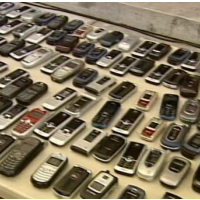20 Prison Employees Fired for Smuggling Cellphones to Inmates for Love and Money
 Cellphones confiscated in California prisons
Cellphones confiscated in California prisons
California’s prison system stumbled ahead on measures to control rampant use of illegal cellphones in correctional institutions by firing 20 workers suspected of smuggling the devices in for inmates. Another 21 are under investigation and allegations were dropped against 13 others, according to a report published by the Department of Corrections and Rehabilitation’s Office of the Inspector General.
Contraband cellphones have proliferated in state prisons, where 15,000 were confiscated from inmates last year. In 2007, the number was 1,400. They have been used by inmates to direct gang activities outside prison, intimidate witnesses in court cases and target guards.
Investigators said most of the prison staff that smuggled the phones did it for money (they are reportedly worth $1,000 apiece), but often they did it for love. Or sex. One guard had sent love letters to a prisoner; another inmate was in possession of a phone containing nude self-photos sent by a female guard; and another female guard received hundreds of calls from an inmate and sent him semi-nude photos of herself. And yet another employee, an office worker, resigned her job when investigators wanted to check for a DNA connection between her child and an inmate.
Efforts to control cellphones in prison have been sporadic and largely ineffective. The prison system is on a pace to recover 12,000 cellphones from inmates this year. While it is against prison rules for inmates to have cellphones, it wasn’t a crime to smuggle one in to them until 2011. Now it’s a misdemeanor punishable by a $5,000 fine and six months in jail.
Prison officials are hoping that a new technological approach will be more effective in controlling the use of illegal phones. The state contracted with Global Tel*Link to build and run a system to filter electronic communications at prisons. It will use “managed” cellphone towers and, when it is completed in 2015, will only let through communications from approved phones.
But a May 2012 study by the California Council on Science and Technology doubted the system would work and suggested it might pose a danger to public safety. The report said the system wouldn’t block 4G, Wi-Fi, MiFi, Skype, text messages or satellite transmissions. It can’t triangulate radio signals, limiting its effectiveness in identifying specific phones or users. And radio frequency leakage could interfere with regular cellphone usage, affecting the public’s access to 911 operators.
The report called the state’s investment in untested technology “unwise” and premature, especially in light of the fact that it really doesn’t even know how many illegal cellphones are floating around the prison system. It recommended using airport-style screening systems and having private carriers identify and disable illicitly phones.
–Ken Broder
To Learn More:
Phone Smuggling Case Costs 20 California Prison Workers Their Jobs (by Jack Dolan, Los Angeles Times)
Report IDs Range of Abuses by Calif. Prison Staff (by Dan Thompson, Associated Press)
High-Tech Plan to Block Prison Cell Phones “Unwise,” Report Says (by Michael Montgomery, KQED)
How California Is Cracking Down on Illegal Cell Phone Use in State Prisons (California Department of Corrections and Rehabilitation)
Cellphone Blocking Moves Ahead in California Prisons (by Ashley Nelson, Government Technology)
California Approves Law Blocking Cell Phone Transmissions in Prisons (by Brian Heaton, Government Technology)
Senate Bill 26 (pdf)
Semi-Annual Report 2012 (Office of the Inspector General) (pdf)
- Top Stories
- Controversies
- Where is the Money Going?
- California and the Nation
- Appointments and Resignations
- Unusual News
- Latest News
- California Forbids U.S. Immigration Agents from Pretending to be Police
- California Lawmakers Urged to Strip “Self-Dealing” Tax Board of Its Duties
- Big Oil’s Grip on California
- Santa Cruz Police See Homeland Security Betrayal in Use of Gang Roundup as Cover for Immigration Raid
- Oil Companies Face Deadline to Stop Polluting California Groundwater





